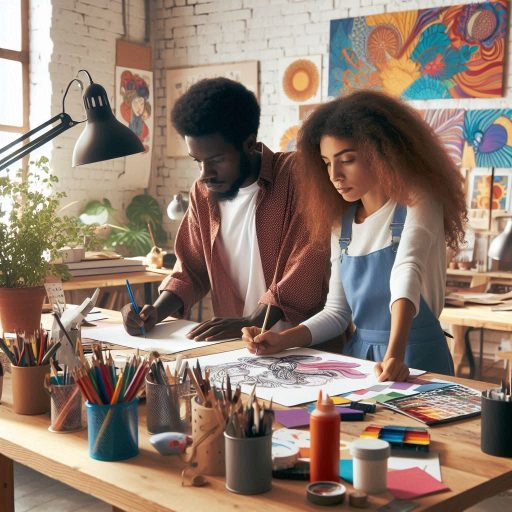Introduction
Creating a stunning art portfolio online is essential for artists seeking to showcase their work effectively and gain recognition in a competitive landscape.
An impressive portfolio serves as a digital gallery, allowing you to present your best pieces to a global audience.
In today‘s art world, where visibility can make or break an artist’s career, having a well-curated portfolio is vital for attracting potential clients and exciting opportunities.
A well-crafted online portfolio provides artists with the freedom to display their creativity and unique style.
It acts as a platform to demonstrate your skills, artistic vision, and personal brand.
By carefully selecting and organizing your artwork, you can highlight your best pieces while also conveying the range of your capabilities.
This curated approach not only showcases your talent but also reflects your professionalism and commitment to your craft.
Moreover, a visually appealing portfolio enhances your chances of gaining visibility in the industry.
Many potential clients and collaborators actively search for artists online, making it crucial to have an engaging and accessible portfolio.
A stunning presentation of your work can capture the attention of art directors, potential clients, and employers, leading to valuable networking opportunities.
Determine your target audience
Define Your Ideal Audience
Identifying your ideal audience is the first step in crafting your portfolio.
Consider the type of art you create and who would appreciate it.
Are you focusing on illustrations for children‘s books, digital art for gaming, or fine art for galleries? Clarifying your niche will guide your decisions.
Conduct research to understand the demographics of your audience.
Explore their interests, preferences, and the types of artwork they gravitate toward.
Use social media platforms and art communities to observe what resonates with your target audience.
Engaging with your potential audience will provide insights into their tastes.
Once you have a clear picture of your ideal audience, you can create art that speaks to them.
This understanding helps you focus your efforts on pieces that will attract their attention.
Tailoring your portfolio to your audience‘s preferences increases the likelihood of connection and engagement.
Tailor Your Portfolio to Cater to Your Target Audience
After defining your audience, you must tailor your portfolio to reflect their interests.
Start by selecting pieces that showcase your strengths and align with your audience’s tastes.
Highlight the artwork that resonates most with them and showcases your unique style.
Ensure your portfolio is visually appealing and easy to navigate.
Organize your work in a way that makes sense to your audience.
Use clear categories or themes to guide viewers through your collection.
A well-structured portfolio enhances the user experience and keeps visitors engaged.
Consider including descriptions for each piece.
Share the inspiration behind your artwork or the techniques you used.
This context helps your audience connect with your work on a deeper level.
Descriptions also demonstrate your thought process and creative journey.
Incorporate high-quality images of your art.
Ensure that the lighting and resolution accurately represent your work.
Poor-quality images can detract from the overall impression of your portfolio.
Aim for a clean and professional presentation to enhance your credibility.
Additionally, make sure your online portfolio is responsive and accessible.
Optimize it for different devices, such as smartphones and tablets.
A seamless experience across all platforms will reach a broader audience and increase engagement.
Finally, continually update your portfolio to reflect your growth as an artist.
As you create new pieces, assess which ones align with your target audience.
Regular updates demonstrate your commitment to your craft and keep your portfolio fresh.
Choose the right platform
Research and Compare Different Online Portfolio Platforms
Start by researching different online portfolio platforms.
Behance, Dribbble, and personal websites are popular choices for artists.
Each platform offers unique features and benefits that cater to different audiences.
Behance is known for its vast community of creatives.
It allows artists to share their projects and receive feedback from peers.
The platform provides a professional layout and easy navigation.
This makes it an excellent choice for those looking to network and gain exposure.
Dribbble focuses on design and illustration.
It is ideal for graphic designers, web designers, and illustrators.
Dribbble emphasizes showcasing small pieces of work, making it perfect for quick sharing.
The community aspect encourages interaction and collaboration, helping artists connect with potential clients.
Creating a personal website gives you complete control over your portfolio.
You can customize the layout, design, and content according to your vision.
Personal websites allow you to showcase a broader range of work without platform restrictions.
However, this option may require more effort in terms of setup and maintenance.
Select a Platform That Best Suits Your Needs and Showcases Your Art Effectively
After researching, assess your goals as an artist.
Consider factors like your target audience, the type of work you create, and your branding.
Choose a platform that aligns with these goals to maximize your portfolio’s effectiveness.
If you aim to connect with other creatives, Behance or Dribbble may be the right choice.
Both platforms encourage networking and community engagement.
They also allow you to receive constructive feedback on your work.
For those wanting complete control over their presentation, consider a personal website.
You can tailor it to showcase your unique style and personality.
Use a clean, professional design to enhance user experience.
Ensure your website is mobile-friendly for accessibility.
No matter which platform you choose, focus on quality over quantity.
Select your best work to showcase, and present it in a cohesive manner.
Use high-resolution images and provide context for each piece.
Write engaging descriptions that tell the story behind your art.
Basically, creating a stunning art portfolio online requires careful consideration.
Research and compare different platforms to find the best fit for your needs.
Select a platform that effectively showcases your art and aligns with your goals.
With the right choice, you can present your creativity and attract the attention you deserve.
Read: Famous Costume Designers in Hollywood
Organize your work effectively
Categorize Your Art into Different Sections or Themes for Easy Navigation
Start by categorizing your artwork into clear sections or themes.
This approach helps visitors navigate your portfolio effortlessly.
Consider dividing your art into categories such as illustrations, paintings, digital art, and photography.
Grouping your work allows viewers to find specific pieces that interest them.
For instance, a potential client may want to view only your illustrations.
By organizing your portfolio, you enhance the user experience and encourage engagement.
Additionally, consider thematic categories based on styles or subjects.
You might have sections for character design, landscapes, or abstract art.
This organization not only makes navigation easier but also highlights your versatility as an artist.
Use descriptive titles for each category.
This practice informs viewers about what to expect in each section.
Ensure that your categories reflect your strengths and showcase your best work.
Arrange Your Pieces in a Visually Appealing and Cohesive Manner
Once you categorize your artwork, focus on arranging your pieces effectively.
Aim for a visually appealing layout that tells a cohesive story.
Consider the flow of your portfolio; each piece should lead naturally to the next.
Choose a consistent style for presenting your artwork.
Use similar framing, spacing, and background colors to create a unified look.
This consistency enhances the overall aesthetic of your portfolio and reinforces your artistic identity.
Arrange your pieces in a way that showcases your best work first.
Highlight standout pieces that represent your skills and style effectively.
Placing these works at the beginning captures viewers’ attention and encourages them to explore further.
Additionally, think about the narrative your portfolio conveys.
Create a logical progression through your work that reflects your artistic journey.
For example, you might start with your earlier pieces and progress to your most recent work, showcasing growth and development.
Use high-quality images of your art.
Ensure that your pieces are well-lit and accurately represent your original work.
Avoid low-resolution images that can detract from the overall quality of your portfolio.
Finally, consider including brief descriptions alongside your pieces.
Share the inspiration behind each work or details about the techniques you used.
These insights add depth to your portfolio and engage viewers on a personal level.
Read: Essential Skills for Aspiring Costume Designers
Highlight your best work
Showcase Your Strongest Pieces
Begin by selecting your strongest pieces for your portfolio.
Choose works that best represent your artistic style and skills.
Quality always outweighs quantity, so focus on a few exceptional pieces rather than a large number of mediocre ones.
Consider including pieces that highlight your creativity, technical skill, and personal voice.
Choose artworks that resonate with your target audience and reflect the type of work you want to pursue.
This approach helps potential clients understand your capabilities and artistic direction.
When displaying your pieces, ensure that high-quality images are used.
Use professional photography or scans to present your work accurately.
Clear, well-lit images allow viewers to appreciate the details and nuances of your art.
Additionally, consider providing context for each piece.
Include titles, descriptions, and the medium used to enhance understanding.
Include a Variety of Artworks
Demonstrating versatility is crucial in appealing to a broader audience.
Include a variety of artworks that showcase different styles, techniques, and mediums.
This variety illustrates your range as an artist and can attract various clients or opportunities.
Consider including illustrations, sketches, paintings, and digital art in your portfolio.
Displaying different styles allows viewers to see your adaptability and creativity.
If you work in multiple genres, such as portraiture, landscapes, or abstract art, make sure to include examples from each.
Furthermore, consider adding personal projects or collaborations that highlight your innovative approach.
These pieces can showcase your ability to think outside the box and tackle diverse subjects.
Including such works demonstrates your passion and commitment to growth as an artist.
Make sure your portfolio is easy to navigate.
Organize your artworks into categories based on style, medium, or theme.
This structure helps viewers find specific pieces quickly and enhances their overall experience.
A user-friendly layout leaves a positive impression on potential clients or collaborators.
In addition, keep your portfolio updated regularly.
As you create new work, replace older pieces that no longer represent your current style or skill level.
An up-to-date portfolio showcases your growth as an artist and keeps your audience engaged.
Read: Top Skills Needed for Art Educators and Instructors

Provide context for your art
Include Descriptions or Artist Statements for Each Piece
Including descriptions for your artwork provides viewers with essential context.
These descriptions can highlight your creative process and the techniques you used.
Explain the materials and methods involved in creating each piece.
This information helps viewers appreciate your artistic journey.
Artist statements can also communicate your intentions.
They provide insight into the themes you explore in your work.
By sharing your thoughts, you invite viewers to connect with your art on a deeper level.
Aim to be concise and articulate your ideas clearly.
This clarity enhances the viewer’s understanding and enjoyment of your work.
Each description should be engaging and informative.
Discuss the challenges you faced while creating the piece.
Highlight any techniques or skills you utilized.
This approach not only informs the audience but also demonstrates your growth as an artist.
Moreover, consider using a consistent format for descriptions to create a cohesive look throughout your portfolio.
The Inspiration Behind Your Art
Your inspiration can significantly impact how viewers perceive your artwork.
Share the stories or experiences that motivated you to create each piece.
Whether it’s nature, personal experiences, or societal issues, revealing your inspiration adds authenticity to your work.
This connection often resonates with viewers and makes your art more relatable.
Inspiration can also stem from other artists, literature, or music.
Discuss how these influences shape your creative process and style.
This insight can foster appreciation for your artistic choices.
Viewers are often intrigued by the thought process behind a piece.
Additionally, clarify the message you aim to convey through your art.
What emotions do you want to evoke? What thoughts or questions do you want to inspire? Clearly articulating your message can deepen the viewer’s engagement.
This clarity transforms passive observation into an active experience.
In general, creating a stunning online art portfolio requires thoughtful presentation.
Including descriptions or artist statements for each piece enriches the viewer’s experience.
Explaining your inspiration and the messages behind your art further enhances this connection.
By thoughtfully communicating your creative process, you invite viewers to explore your work more meaningfully.
Ultimately, this approach helps you build a strong online presence and engage effectively with your audience.
Read: Collaborating with Other Creative Roles
Keep it updated
Regularly Update Your Portfolio with New Artwork to Keep It Fresh and Engaging
Keeping your portfolio updated with new artwork demonstrates your growth as an artist.
Regular updates allow you to showcase your latest skills and techniques.
This practice keeps your audience engaged and eager to see your progress.
Aim to add new pieces every few months.
Highlight recent projects, experimental styles, or collaborations to illustrate your versatility.
This fresh content will attract returning visitors and new viewers alike.
Updating your portfolio also reflects your current artistic direction.
As you evolve, your portfolio should mirror these changes.
Showcasing your best work allows potential clients to understand your unique style and capabilities.
Consider using themes or concepts when adding new artwork.
This approach creates a cohesive narrative within your portfolio.
Grouping similar pieces together enhances the viewing experience and helps visitors connect with your work.
Remove Any Outdated or Low-Quality Pieces to Maintain a Polished and Professional Appearance
Outdated or low-quality pieces can detract from your overall presentation.
Regularly review your portfolio and remove artwork that no longer represents your current skill level.
This action helps maintain a polished and professional appearance.
Assess each piece critically.
If a work doesn‘t meet your current standards, consider replacing it with something more relevant.
A focused portfolio showcases your best work, reinforcing your professionalism.
Aim for quality over quantity in your portfolio.
It‘s better to have a smaller selection of excellent pieces than a larger collection of mediocre work.
This approach highlights your strengths and encourages viewers to appreciate your artistic abilities.
Ensure that each piece you include in your portfolio is well-photographed or scanned.
Poor-quality images can misrepresent your artwork and hinder its impact.
Invest time in presenting your work professionally, showcasing its true beauty.
Additionally, consider the order of your pieces.
Arrange them strategically to guide the viewer through your portfolio.
Start with your strongest work to make a lasting impression.
Generally, creating a stunning online art portfolio requires regular updates and a focus on quality.
Consistently add new artwork to keep your portfolio fresh and engaging.
At the same time, remove outdated or low-quality pieces to maintain a polished appearance.
These practices ensure that your portfolio effectively represents your artistic journey and captivates your audience.
By prioritizing quality and freshness, you can create a portfolio that stands out in the competitive art world.
Discover More: Typography Software: Best Tools for Designers
Promote your portfolio
Once you have created a stunning art portfolio online, the next step is to promote it effectively.
Promoting your portfolio is essential to gaining exposure and attracting potential clients or collaborators.
Here are some tips on how to promote your art portfolio
Share your portfolio on social media platforms
One of the easiest and most effective ways to promote your art portfolio is by sharing it on social media platforms.
Platforms like Instagram, Facebook, Twitter, and Pinterest are great for showcasing your work to a wide audience.
Make sure to include high-quality images of your artwork and a compelling description to engage viewers.
You can also use relevant hashtags to reach potential clients or collaborators who are searching for specific types of art.
Transform Your Career Today
Unlock a personalized career strategy that drives real results. Get tailored advice and a roadmap designed just for you.
Start NowJoin art communities
Another way to promote your portfolio is by joining online art communities.
Websites like DeviantArt, Behance, and Dribbble are popular platforms where artists can showcase their work, connect with other artists, and receive feedback.
By participating in these communities, you can reach a larger audience and potentially attract new clients or collaborations.
Be active in these communities by sharing your work, commenting on others’ work, and engaging in discussions to increase your visibility.
Network with other artists and industry professionals
Networking is an essential part of promoting your art portfolio.
By connecting with other artists and industry professionals, you can expand your reach and potentially open up new opportunities.
Attend art events, workshops, and exhibitions to meet like-minded individuals and build relationships.
Collaborating with other artists on projects or exhibitions can also help you gain exposure and attract new clients.
Additionally, reaching out to galleries, art agencies, and potential clients can lead to potential partnerships or commissioned work.
Essentially, promoting your art portfolio is crucial to establishing yourself as an artist and attracting opportunities.
By using social media platforms, joining art communities, and networking with other artists, you can increase your visibility and reach a wider audience.
Remember to showcase your work effectively, engage with your audience, and be proactive in promoting your portfolio to achieve success in the art world.
Conclusion
In this blog, we explored the essential steps to create a stunning online art portfolio.
We emphasized the importance of selecting your best work and presenting it cohesively.
A strong portfolio not only highlights your unique style but also effectively showcases your skills and versatility as an artist.
Curating a compelling portfolio requires thoughtful organization and a clean, user-friendly layout.
Begin by choosing a platform that suits your artistic needs, whether it‘s a personal website, portfolio site, or social media.
Ensure your chosen platform allows for easy navigation and clear presentation of your artwork.
Including detailed descriptions and context for each piece can engage your audience and provide insight into your creative process.
Additionally, optimizing your portfolio for mobile viewing is crucial in today‘s digital landscape.
Many viewers will access your work on their phones or tablets, so ensuring accessibility enhances the user experience.
Regularly updating your portfolio to reflect your growth and new projects keeps your content fresh and relevant.
I encourage artists to invest time and effort in crafting a standout portfolio.
Your online presence is critical for attracting clients, galleries, and art enthusiasts.
A well-curated portfolio acts as your visual resume, effectively communicating your artistic vision and capabilities.




